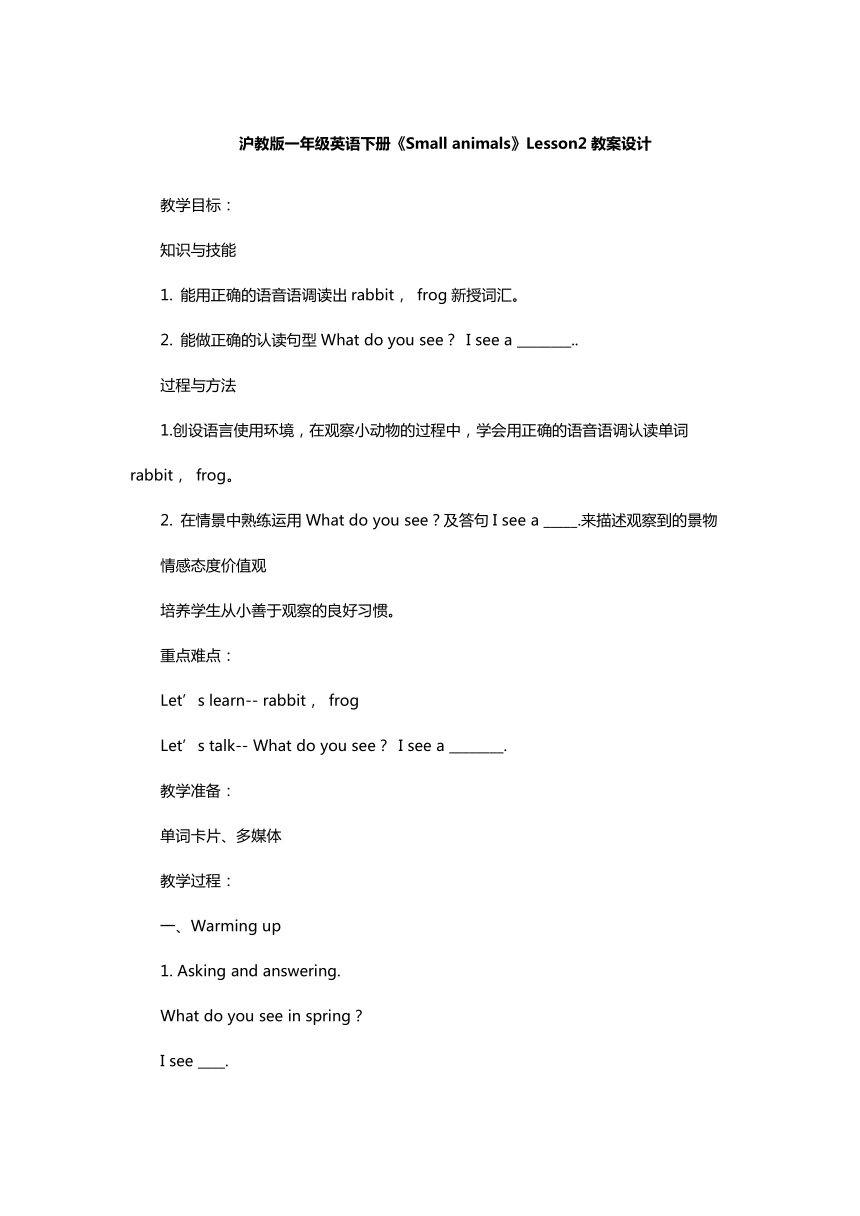Unit2 Small animals Lesson2 教案
文档属性
| 名称 | Unit2 Small animals Lesson2 教案 |

|
|
| 格式 | zip | ||
| 文件大小 | 4.1KB | ||
| 资源类型 | 教案 | ||
| 版本资源 | 上海牛津(绿色上教版) | ||
| 科目 | 英语 | ||
| 更新时间 | 2019-05-05 08:51:49 | ||
图片预览


文档简介
沪教版一年级英语下册《Small animals》Lesson2教案设计
教学目标: 知识与技能 1. 能用正确的语音语调读出rabbit, frog新授词汇。 2. 能做正确的认读句型What do you see? I see a ________.. 过程与方法 1.创设语言使用环境,在观察小动物的过程中,学会用正确的语音语调认读单词 rabbit, frog。 2. 在情景中熟练运用What do you see?及答句I see a _____.来描述观察到的景物 情感态度价值观 培养学生从小善于观察的良好习惯。 重点难点: Let’s learn-- rabbit, frog Let’s talk-- What do you see? I see a ________. 教学准备: 单词卡片、多媒体 教学过程: 一、Warming up 1. Asking and answering. What do you see in spring? I see ____. 二、Learn new lesson 1. 教师将兔子图片贴在草地上 Listen and look, who is coming? I am a rabbit. I like spring. I like to eat grass. 2. What do you see in the tree? What do you see on the flowers? 3. 运用学生学过的对话引出本课的新授内容 Who’s coming? I am a frog. I can jump. I can swim. I am a small animal, too. I can’t fly. I can run. I can jump. I have got two long ears. Who am I? 4. 在感知rabbit这个单词的正确发音后,教师示范I am Grandmother Rabbit。模仿老兔子的样子,缓慢地跳动并用苍老的声音说Rabbit, rabbit, jump, jump, jump.学生模仿练习。
5. 要求学生根据老师所说的内容做出不同的动作,并说出以上话语。( Grandfather Rabbit, Uncle Rabbit, Sister Rabbit,…) 小组活动或对子活动拟物仿说。 6. 用类似的方法练习bird, bee 7. 结合屏幕显示的画面,教师引导学生仔细观察小动物的神情,请学生用不同语调向小鸟打招呼。 8. 结合屏幕显示的画面,教师引导学生仔细观察小动物的神情,请个别学生大声呼唤,向动物打招呼。 9. 教师出示一张画有许多青蛙的图片, What do you see in the picture? What can a frog do? Is it big? 10. 在学完bird, bee, butterfly三个单词的正确发音后,老师根据动物的运动方式以及联系课文插图编出儿歌,先示范朗读 bird Bird, bird, It can fly. Where, where, It’s on the tree. 三、Practice and consolidation 1. 看黑板上的图片,要求学生运用What do you see? I see a _____.来询问别人观察到的动物。 2. 选择最喜欢的动物演一演,并用一至三句话介绍一下。 I am a ____. I am _____. I can ____. … 3. 练习册第六页Look, listen and choose. 听录音,按要求完成第六页上的练习 板书设计: Unit 2 Small animals rabbit, frog What do you see? I see a _____.
教学目标: 知识与技能 1. 能用正确的语音语调读出rabbit, frog新授词汇。 2. 能做正确的认读句型What do you see? I see a ________.. 过程与方法 1.创设语言使用环境,在观察小动物的过程中,学会用正确的语音语调认读单词 rabbit, frog。 2. 在情景中熟练运用What do you see?及答句I see a _____.来描述观察到的景物 情感态度价值观 培养学生从小善于观察的良好习惯。 重点难点: Let’s learn-- rabbit, frog Let’s talk-- What do you see? I see a ________. 教学准备: 单词卡片、多媒体 教学过程: 一、Warming up 1. Asking and answering. What do you see in spring? I see ____. 二、Learn new lesson 1. 教师将兔子图片贴在草地上 Listen and look, who is coming? I am a rabbit. I like spring. I like to eat grass. 2. What do you see in the tree? What do you see on the flowers? 3. 运用学生学过的对话引出本课的新授内容 Who’s coming? I am a frog. I can jump. I can swim. I am a small animal, too. I can’t fly. I can run. I can jump. I have got two long ears. Who am I? 4. 在感知rabbit这个单词的正确发音后,教师示范I am Grandmother Rabbit。模仿老兔子的样子,缓慢地跳动并用苍老的声音说Rabbit, rabbit, jump, jump, jump.学生模仿练习。
5. 要求学生根据老师所说的内容做出不同的动作,并说出以上话语。( Grandfather Rabbit, Uncle Rabbit, Sister Rabbit,…) 小组活动或对子活动拟物仿说。 6. 用类似的方法练习bird, bee 7. 结合屏幕显示的画面,教师引导学生仔细观察小动物的神情,请学生用不同语调向小鸟打招呼。 8. 结合屏幕显示的画面,教师引导学生仔细观察小动物的神情,请个别学生大声呼唤,向动物打招呼。 9. 教师出示一张画有许多青蛙的图片, What do you see in the picture? What can a frog do? Is it big? 10. 在学完bird, bee, butterfly三个单词的正确发音后,老师根据动物的运动方式以及联系课文插图编出儿歌,先示范朗读 bird Bird, bird, It can fly. Where, where, It’s on the tree. 三、Practice and consolidation 1. 看黑板上的图片,要求学生运用What do you see? I see a _____.来询问别人观察到的动物。 2. 选择最喜欢的动物演一演,并用一至三句话介绍一下。 I am a ____. I am _____. I can ____. … 3. 练习册第六页Look, listen and choose. 听录音,按要求完成第六页上的练习 板书设计: Unit 2 Small animals rabbit, frog What do you see? I see a _____.
